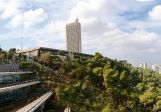Feeding the Multitude Miracle and its Connection to the New Mosaic Floor Exposed at Hippos
A colorful mosaic, well-preserved and laden with decorations, including dedication inscriptions and descriptions of baskets with loaves and fish, was exposed in the excavation at the “Burnt Church” in Hippos. According to the researchers, the descriptions in the mosaic along with the location of the church, overlooking the Sea of Galilee, immediately raise the connection to the Feeding the Multitude (the 5000) miracle performed by Jesus, according to the New Testament, in the area. “There can certainly be different explanations to the descriptions of loaves and fish in the mosaic, but you cannot ignore the similarity to the description in the New Testament: for example, from the fact that the New Testament has a description of five loaves in a basket or the two fish depicted in the apse, as we find in the mosaic”, said Dr. Michael Eisenberg, head of the excavation team in Hippos on behalf of the Institute of Archaeology.
Hippos, which overlooks the Sea of Galilee from the top of a mountain approximately 2 km to the east, is located within the Hippos National Park of the Israel Nature and Parks Authority. It was the central city in the region around the eastern Sea of Galilee and the south of the Golan during Roman and Byzantine times. The ancient city has been exposed over the past twenty years by an expedition on behalf of the Institute for Archaeology.
A few weeks ago, the researchers exposed the Burnt Church, built in the second half of fifth-early sixth century AD and was probably burnt down during the Sasanian conquest in the beginning of the seventh century. This church was partially exposed about a decade ago, and now Dr. Eisenberg and his partner in managing the excavation, Arleta Kowalewska, have returned to expose it. The fire caused the church mosaic floor to be conserved in an amazing way, since the roof was burnt down and collapsed on the floor of the church and covered it in a layer of ash, thus protecting it from being damaged over time. Now, as the researchers have returned to expose it, they have found a magnificent mosaic, which was excellently preserved. The excavation of the church was placed in the hands of Jessica Rentz from the USA, who has exposed the entire internal area of the church, at an area of 10×15 meters. During the excavation of the main portal, she exposed within the remains of the burnt doors, a pair of door knockers in bronze casting in the form of roaring lions. During the preservation process, headed by Yana Vitkalov from the Israel Antiquities Authority, most of the mosaic area was cleaned and preserved, and most of its decorations and two inscriptions in Greek were exposed. The first one tells about the two fathers of the church, Theodoros and Petros constructing a sanctuary for a martyr, while the second one, which is located inside a medallion at the center of the mosaic, exposes the name of the martyr – Theodoros. An initial reading of the inscriptions was done by Dr. Gregor Staab from the University of Cologne in Germany, expedition epigraphist.
According to Dr. Eisenberg, the people who ordered the mosaic wanted to create an extremely prominent and dense colorfulness, which includes geometric patterns and depictions of birds, fish and fruit placed densely throughout the mosaic. In some of the baskets, the researchers have found five or more loaves in different colors, which, along with the fish, were associated to the Feeding the Multitude miracle described four times in the New Testament. According to the New Testament, Jesus performed the miracle in an isolated area, probably in the northeast part of the Sea of Galilee, where he used five loaves and two fish to feed a multitude of 5,000 men without counting the women and children. Later, as the story goes, he performed the miracle of walking on water and reached the north-west of the Sea of Galilee. At this place, around current day Kibbutz Ginosar/Tabgha, the Church of the Multiplication was built already in the fifth century, and according to the early Christian tradition, is where the miracle took place.
Dr. Eisenberg continues to be cautious about the interpretation of the new mosaic, however he states that there are a number of points worth paying attention to, “nowadays, we tend to regard the Church of the Multiplication in Tabgha on the north-west of the Sea of Galilee as the location of the miracle, but with careful reading of the New Testament it is evident that it might have taken place north of Hippos within the city’s region. According to the scripture, after the miracle Jesus crossed the water to the north-west of the Sea of Galilee, to the area of Tabgha/Ginosar, so that the miracle had to take place at the place where he began the crossing rather than at the place he finished it. In addition, the mosaic at the Church of Multiplication has a depiction of two fish and a basket with only four loaves , while in all places in the New Testament which tell of the miracle, there are five loaves of bread, as found in the mosaic in Hippos. In addition, the mosaic at the burnt church has a depiction of 12 baskets, and the New Testament also describes the disciples who, at the end of the miracle, were left with 12 baskets of bread and fish”, stated Dr. Eisenberg.
However, he is also aware that there are also differences between the depiction in the mosaic at the burnt church and the description in the New Testament: thus, for example, some of the baskets in the mosaic are full of fruit and not only bread, and in other places there are three fish, one next to the other, and not only two. “The church is located right at the western edge of Mount Sussita and is the most western point in the city and overlooks – today as it did then – the Sea of Galilee and Jesus ministry and where most of his miracles occurred. There is no doubt that the local community was well familiar with the two miracles of Feeding the Multitude and perhaps knew their estimated locations better than us. The assumption that the artisan or the persons who ordered the work wanted to create an affinity to a miracle which took place nearby must be logical. We will finish the excavation and cleaning of the remaining twenty percent of the mosaic and will carefully examine this assumption. The fish themselves have a number of additional symbolical meaning in the Christian world, and their interpretation requires caution”, he summarized.




